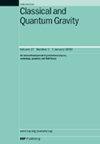Tilt-to-length coupling in LISA—uncertainty and biases
IF 3.6
3区 物理与天体物理
Q2 ASTRONOMY & ASTROPHYSICS
引用次数: 0
Abstract
The coupling of the angular jitter of the spacecraft and their sub-assemblies with the optical bench and the telescope into the interferometric length readout will be a major noise source in the LISA mission. We refer to this noise as tilt-to-length (TTL) coupling. It will be reduced directly by realignments, and the residual noise will then be subtracted in post-processing. The success of these mitigation strategies depends on an accurate computation of the TTL coupling coefficients. We present here a thorough analysis of the accuracy of the coefficient estimation under different jitter characteristics, angular readout noise levels, and gravitational wave sources. We analyze in which cases the estimates degrade using two estimators, the common least squares estimator and the instrumental variables estimator. Our investigations show that angular readout noise leads to a systematic bias of the least squares estimator, depending on the TTL coupling coefficients, jitter and readout noise level, while the instrumental variable estimator converges to an unbiased result as the data set length increases. We present an equation that predicts the estimation bias of the least squares method due to angular readout noise.求助全文
约1分钟内获得全文
求助全文
来源期刊

Classical and Quantum Gravity
物理-天文与天体物理
CiteScore
7.00
自引率
8.60%
发文量
301
审稿时长
2-4 weeks
期刊介绍:
Classical and Quantum Gravity is an established journal for physicists, mathematicians and cosmologists in the fields of gravitation and the theory of spacetime. The journal is now the acknowledged world leader in classical relativity and all areas of quantum gravity.
 求助内容:
求助内容: 应助结果提醒方式:
应助结果提醒方式:


